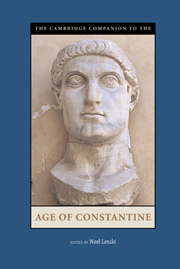Book contents
- Frontmatter
- Introduction
- 1 Sources for the History of Constantine
- Section 1 Politics and Personalities
- Section II Religion and Spiritual Life
- Section III Law and Society
- Section IV Art and Culture
- Section V Empire and Beyond
- 14 Warfare and the Military
- 15 Constantine and the Northern Barbarians
- 16 Constantine and the Peoples of the Eastern Frontier
- Appendix 1: Stemmata
- Appendix 2: Timeline
- Maps
- Primary Sources and Translations
- Secondary Bibliography
- Index
16 - Constantine and the Peoples of the Eastern Frontier
from Section V - Empire and Beyond
Published online by Cambridge University Press: 28 September 2007
- Frontmatter
- Introduction
- 1 Sources for the History of Constantine
- Section 1 Politics and Personalities
- Section II Religion and Spiritual Life
- Section III Law and Society
- Section IV Art and Culture
- Section V Empire and Beyond
- 14 Warfare and the Military
- 15 Constantine and the Northern Barbarians
- 16 Constantine and the Peoples of the Eastern Frontier
- Appendix 1: Stemmata
- Appendix 2: Timeline
- Maps
- Primary Sources and Translations
- Secondary Bibliography
- Index
Summary
With the power of this God as my ally, beginning from the shores of Ocean I have raised up the whole world step by step with sure hopes of salvation.
Constantine’s letter to Shapur II, King of Persia (Eus. VC 4.9.)For the Emperor Constantine, the east was both a goal and a return. By the end of his reign, victory over the Persian empire was “what he had still to achieve,” but his motivations for eastern conquest were complex. Strategic concerns about Rome’s eastern provinces were joined with a vision of a universal Christian empire in an intimate marriage of interests that has perplexed commentators both ancient and modern. Constantine’s propaganda repeats the image suggested in the epigraph above, not just in this letter to the Persian shah, Shapur II (309
10-379), but also in the emperor’s letter to the eastern provincials. So too, in his Life of Constantine, Eusebius of Caesarea portrays Constantine’s triumphal progress from Britain and the remotest western Ocean, eastward toward India and the sun:
[Constantine] campaigned against the land of the Britons and the dwellers at the very Ocean where the sun sets. He annexed the whole Scythian population, which was in the far north divided into numerous barbarian tribes; and once he had also extended his Empire in the extreme south as far as the Blemmyes and the Aethiopians, he did not treat the acquisition of what lay in the orient as beyond his scope, but illuminating with beams of light of true religion the ends of the whole inhabited earth, as far as the outermost inhabitants of India and those who live round the rim of the whole dial of earth, he held in subjection all the toparchs, ethnarchs, satraps and kings of barbarian nations of every kind.
- Type
- Chapter
- Information
- The Cambridge Companion to the Age of Constantine , pp. 377 - 398Publisher: Cambridge University PressPrint publication year: 2005

